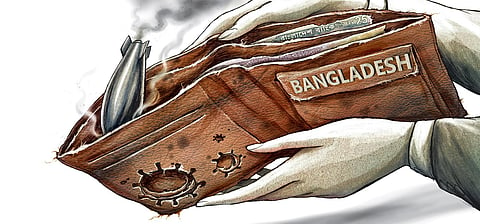Bangladesh grapples with economic stress
Bangladesh’s economic growth has run into rough weather, belying its reputation as the fastest growing economy in Asia. It received accolades for its successful economic growth story with 7–8% GDP in the pre-Covid era. The GDP rose to USD 416 billion, and per capita GDP exceeded that of India. The country is now struggling to manage the damage caused by the double whammy of the continuing Covid pandemic and the Ukraine War. External factors apart, domestic factors have also contributed to the economic crisis. With Bangladesh seeking external multilateral financial support, three of India’s neighbours are mired in deep economic turbulence.
Bangladesh joins Sri Lanka and Pakistan in seeking bailouts from the IMF. It is seeking a loan of USD 4.5 billion from the IMF, accompanied by economic belt-tightening measures to cut back foreign exchange expenditure.
The IMF’s readiness to help Bangladesh with a bailout package over the next three years is a clear acknowledgement of the country’s economic crisis. Bangladesh has also knocked on the door of the World Bank for a billion-dollar loan, and USD 2.5–3 billion have been sought from other multilateral institutions and donor nations like Japan.
Bangladesh is an energy and food importer. Agriculture depends on imported fertilisers, whose cost has escalated because both Russia and Ukraine are also fertiliser exporters. Fuel prices have been raised by 50% to reduce the subsidy burden on the treasury. Other austerity measures include power rationing, cutting back on foreign travel by government officials, limiting the purchase of government vehicles and ban on non-essential and luxury items. The fuel price rise will stoke the fire of inflation, running at over 7% since July this year.
In August this year, Bangladesh’s foreign exchange reserves had come down from an all-time high of USD 48 billion to USD 45 billion and then to USD 39 billion, which can sustain 5-months of imports. The government has pleaded that its hands are tied, and it had no other option.
The move also anticipates the expected conditions to be applied by the IMF for extending any loan. The opposition, already attacking the government on various issues before the general election next year, has slammed the government for the fuel price rise. The frustrated opposition has found the economic crisis a new peg to attack the government.
High oil and food prices have led to a slide in foreign exchange reserves, as import bills have risen. Most analysts in Bangladesh believe that the country’s economic crisis may not end soon. The slowdown in the global economy has impacted Bangladesh’s export markets. 80% of Bangladesh’s exports are Ready Made Garments [RMG], and depressed consumer demand in the developed and developing economies has seen far fewer orders for RMG companies. Remittances from Bangladeshis working abroad [NRBs] have also fallen, depleting foreign reserves. Remittance inflows peaked at USD 24.77 billion and have now fallen to USD 21 billion. The Bangladeshi Taka [BDT] fell sharply against the US dollar, falling to BDT 112 per dollar in the market. Bangladesh’s trade deficit is on the rising curve. Though exports have touched USD 52 billion, imports have also risen, leaving a deficit of USD 33 billion.
Compounding these economic stress factors is Bangladesh’s poor record in controlling trade-based money laundering. An estimated USD 7 billion is leaving Bangladesh due to over-invoicing of imports and under-invoicing of exports. According to the Swiss National Bank, Bangladeshi nationals have stashed away around USD 917 billion in Swiss banks. Debt servicing has added an increasing burden on the treasury. Foreign debt worth USD 90 billion has accumulated on loans taken for large infrastructure projects.
Around USD 43 billion is owed to China, Japan and Russia. Some major infrastructure projects are being shelved. The country’s finance minister has warned that BRI infrastructure loans from China require far more scrutiny to establish their financial feasibility.
Austerity measures have led to public protests and allegations of mismanagement and corruption against the government. Critics have blamed the government and the ruling Awami League [AL] for increasing dependence on fuel imports for power plants to increase power production and not investing in oil and gas exploration.
While Bangladesh has celebrated the opening of the bridge on the Padma river and claimed it is self-financed, several billions of dollars have been borrowed from major development partners and multilateral institutions for budgetary support.
The economic picture was not as rosy as proclaimed by the government. Inflated cost of infrastructure projects, non-performing assets and loan defaults have caused a crisis in the banking sector, mainly owing to crony capitalism. Vanity projects like the Roopur Nuclear Power Plant and mega projects like the Dhaka Metro Rail, Karnaphuli Tunnel and several other projects have put pressure on the country’s finances, as costs have soared because of overpricing and corruption.
The public alert sounded by Bangladesh’s finance minister about China’s BRI debt-trap policy towards developing and less developed countries is a significant comment on China’s role in capturing physical assets like the Hambantota Port in Sri Lanka via financing fiscally unsustainable vanity projects that are obtained through high-level political bribery. The widespread public protests in Sri Lanka, which forced its president to flee the country, have sent shock waves across the region. India’s neighbours, barring Bhutan, have all joined China’s BRI programme, and the Sri Lankan case is a lesson for all these countries.
The economic crisis in India’s neighbourhood highlights the dangers of playing the “China Card” against India. China fully understands this sentiment and, with its chequebook diplomacy, has successfully tempted these countries to walk into the current economic crisis. China’s geopolitical interest in pushing the BRI and debt-trap diplomacy is designed to contain India’s influence and promote China’s clout in India’s neighbourhood, apart from increasing its strategic footprint in the Indian Ocean Region.
Pinak Ranjan Chakravarty
Former Secretary in MEA & former Ambassador; Visiting Fellow at ORF, Delhi
(pr.chakravarty @gmail.com)

